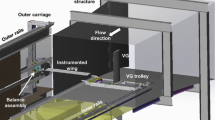Abstract
The calculation of aerodynamic characteristics of a wing is the basic problem for aerodynamic design of aircraft. Wing aerodynamics can be determined experimentally and numerically. The method of fixing the wing in the test chamber of wind tunnel is related to disturbance of flow through the wing. When the wing is entirely fixed in the test chamber, the disturbance is usually caused by the sting connecting the wing to the test chamber. The experiments in this paper fixed the wing by clamping to the wind tunnel wall at the wing symmetry surface (root section). With this wing fixation, it was possible to take advantage of the wingspan twice, but to obtain the 3D wing experiment results, it was necessary to evaluate the impact of the wind tunnel wall effect. As for aircrafts, the aerodynamic force of the aircraft’s wing will have certain difference than that of the wing alone. The intersection region between the wind tunnel wall and wing root (for the experiment), as well as between the fuselage and wing root have complex interactions of boundary layers, in particular separation phenomena in the boundary layers. By solving the differential equation for viscous flows, it was possible to visualize the picture of streamlines and flow separations in this interference region and the aerodynamic characteristics of the wing. The singularity method was also used to compare results within its application range. The aerodynamic coefficients in the two cases with and without interference were analyzed. Complex interactions in the interference region could alter the predicted aerodynamic force calculated for the wing alone, which should be estimated. Very strong separations in the wing-fuselage interference region at large angles of attack turned into vortices at the rear impacting on the horizontal tail aerodynamics that is related to the balance problem of the aircraft.
Similar content being viewed by others
References
Y. S. Won, B. A. Haider, C. H. Sohn and Y. M. Koo, Aerodynamic performance evaluation of basic airfoils for an agricultural unmanned helicopter using wind tunnel test and CFD simulation, J. of Mechanical Science and Technology, 31 (12) (2017) 5829–5838.
M. Masdari, M. Jahanmiri, M. R. Soltani, A. Tabrizian and M. Gorji, Experimental investigation of a supercritical airfoil boundary layer in pitching motion, J. of Mechanical Science and Technology, 31 (1) (2017) 189–196.
J. Piquee and C. Breitsamter, Numerical and experimental investigations of an elasto-flexible membrane wing at a Reynolds number of 280000, Aerospace, 4 (2017) 39–55.
G. Fillola, G. Carrier and J-B. Dor, Experimental study and numerical simulation of flow around wing control surface, ICAS-Secretariat - 25th Congress of the International Council of the Aeronautical Sciences (2006).
E. Tangermann, M. Klein, S. L. Herbst, R. Hain and C. J. Kahler, Numerical and experimental investigation of the flow around a three-dimensional SD7003 wing, 10th International Symposium on Turbulence and Shear Flow Phenomena (TSFP10), Chicago, USA (2017).
M. R. Soltani, M. Masdari and M. R. Tirandaz, Effect of an end plate on surface pressure distributions of two swept wings, Chinese J. of Aeronautics, 30 (5) (2017) 1631–1643.
M. Hadidoolabi and H. Ansarian, Supersonic flow over a pitching delta wing using surface pressure measurements and numerical simulations, Chinese J. of Aeronautics, 31 (1) (2017) 65–78.
H. Sobieczky, Configuration test cases for aircraft wing root design and optimization, International Symposium on Inverse Problems in Engineering Mechanics, Nagano, Japan (1998) 371–380.
W. D. Wolhart and D. F. Thomas Jr, Static Longitudinal and Lateral Stability Characteristics at Low Speed of Unswept-Midwing Models Having Wings with an Aspect Ratio of 2, 4, or 6, National Advisory Committee for Aeronautics, Langley Aeronautical Lab, Washington, USA (1956).
M. H. Nguyen and T. B. N. Hoang, Experimental study of laminar separation phenomenon combining with numerical calculations, Vietnam J. of Mechanics, 33 (2) (2011) 95–104.
T. B. N. Hoang and V. B. Bui, Experimental and numerical studies of wing-tip effect and wing downwash affecting the horizontal tail, J. of Mechanical Science and Technology, 33 (2) (2019) 649–659.
T. B. N. Hoang, Computational investigation of the variation in wing aerodynamic load under the effect of aeroelastic deformations, J. of Mechanical Science and Technology, 32 (10) (2018) 4665–4673.
J. Katz and A. Plotkin, Low Speed Aerodynamics, 2nd Ed., Cambridge University Press, New York, USA (2001).
S. Ristic, Flow visualisation techniques in wind tunnels Part I — Non optical methods, Scientific Technical Review, LVII No. 1 (2007).
D. Filipiak, R. Szczepaniak, T. zahorski, R. Babel, S. Stabryn and W. Stryczniewicz, Flow visualization over an airfoil with flight control surfaces in a water tunnel, Transactions of the Institute of Aviation, 1 (246) (2017) 63–78.
H. S. Nguyen, T. B. N. Hoang, V. P. Dinh and M. H. Nguyen, Experiments and numerical calculation to determine aerodynamic characteristics of flows around 3D wings, Vietnam J. of Mechanics, 36 (2) (2014) 133–143.
R. Berger and L. M. M. Boermans, Aerodynamic design of the wing-fuselage junction for the high-performance sailplane Mu-31, Technical Soaring, 28 (3) (2004) 13–23.
N. Deng, Q. Qu and R. K. Agarwal, Numerical study of the aerodynamics of DLR-F6 wing-body in unbounded flow field and in ground effect, 55th AIAA Aerospace Sciences Meeting, Texas (2017).
H. Schlichting and E. A. Truckenbrodt, Aerodynamics of the Airplane, McGraw-Hill, USA (1979).
Author information
Authors and Affiliations
Corresponding author
Additional information
Recommended by Associate Editor Hyoung-Bum Kim
Hoang Thi Bich Ngoc, who is an Associate Professor at the School of Transportation Engineering, HUST, Vietnam, acquired her M.A. and Ph.D. in France. Fields of interest include aerodynamics, aeroelasticity, flight mechanics, turbo-machines, and computational calculations.
Bui Vinh Binh received his B.E. (2012) from the Excellent Engineer Training Program (PFIEV) and his M.A. (2014) at HUST. He is currently a Ph.D. candidate at HUST. Fields of interest include aerodynamics and airplane stability.
Rights and permissions
About this article
Cite this article
Hoang, N.T.B., Bui, B.V. Investigation of wind tunnel wall effect and wing-fuselage interference regarding the prediction of wing aerodynamics and its influence on the horizontal tail. J Mech Sci Technol 33, 2737–2746 (2019). https://doi.org/10.1007/s12206-019-0520-x
Received:
Revised:
Accepted:
Published:
Issue Date:
DOI: https://doi.org/10.1007/s12206-019-0520-x




